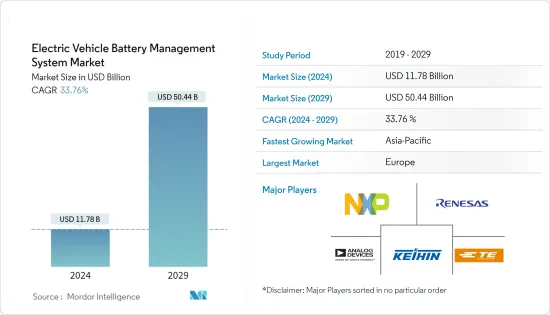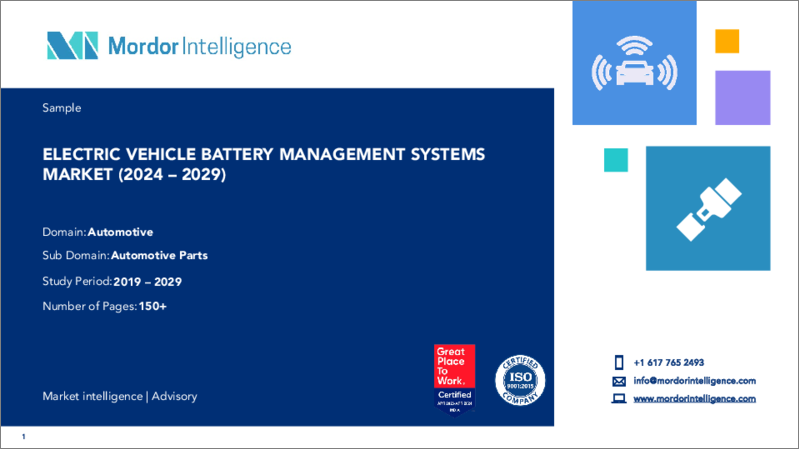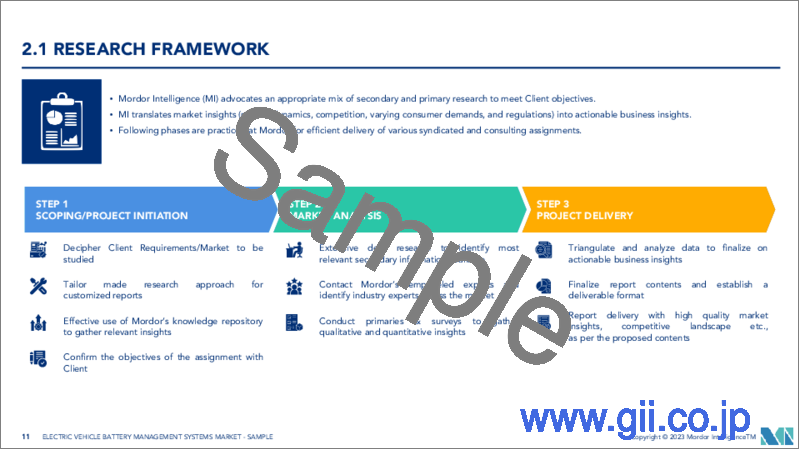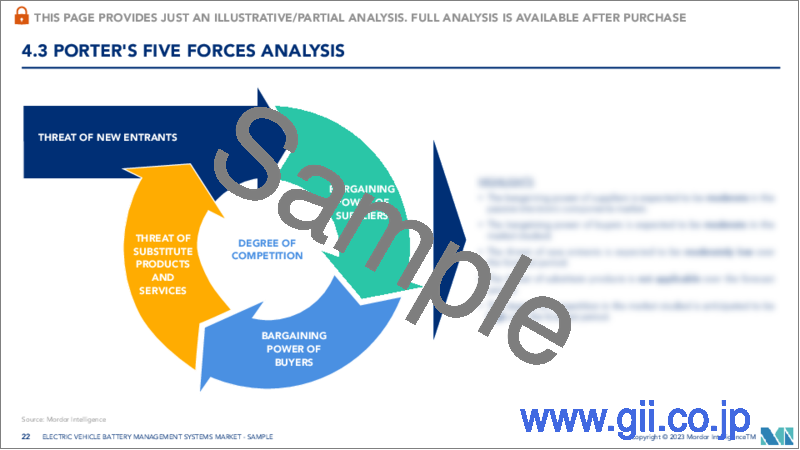|
|
市場調査レポート
商品コード
1440276
電気自動車バッテリー管理システム:市場シェア分析、業界動向と統計、成長予測(2024~2029年)Electric Vehicle Battery Management System - Market Share Analysis, Industry Trends & Statistics, Growth Forecasts (2024 - 2029) |
||||||
|
● お客様のご希望に応じて、既存データの加工や未掲載情報(例:国別セグメント)の追加などの対応が可能です。 詳細はお問い合わせください。 |
|||||||
| 電気自動車バッテリー管理システム:市場シェア分析、業界動向と統計、成長予測(2024~2029年) |
|
出版日: 2024年02月15日
発行: Mordor Intelligence
ページ情報: 英文 150 Pages
納期: 2~3営業日
|
- 全表示
- 概要
- 目次
電気自動車バッテリー管理システムの市場規模は、2024年に117億8,000万米ドルと推定され、2029年までに504億4,000万米ドルに達すると予測されており、予測期間(2024年から2029年)中に33.76%のCAGRで成長します。

新型COVID-19感染症による世界の自動車産業への悪影響にも関わらず、2020年の電気自動車販売は世界中で大幅な増加を記録しました。これは主に政府の補助金、電気自動車の充電インフラの拡大、燃料価格の上昇によるものです。 2021年にも同じ成長傾向が見られ、予測期間中は継続する可能性があります。パンデミックにより世界のサプライチェーンが混乱し、BMSコンポーネントとシステムの生産と配送に遅れと不足が生じています。一方で、パンデミックにより電気自動車の導入も加速し、BMS技術の需要が高まっています。全体として、パンデミックがBMS業界に与える長期的な影響はプラスになる可能性が高いです。
中期的には、持続可能な輸送とクリーンなエネルギーに対する需要の高まりにより、バッテリー式電気自動車の需要が高まっています。車種範囲、高額な前払い価格、限られたモデルの入手可能性、知識不足などの消費者の制約は、プロモーション活動や政府の法律によって解決されつつあります。これらの変数は電気自動車の需要に影響を及ぼし、バッテリー管理システム市場を牽引することになります。
バッテリー管理システム(BMS)の需要は、電気自動車の導入増加により、世界中で急速に成長すると予想されています。しかし、アジア太平洋地域では急速な工業化と都市化が進んでおり、中国やインドなどの国々で電気自動車の需要が高まっているため、BMS市場をリードすると予想されています。北米や欧州などの他の地域でも、BMS市場は大幅に成長すると予想されています。
電気自動車の需要の高まりは、バッテリーの化学および材料の技術進歩につながり、バッテリーの安全性と性能を確保するために、より高度で効率的なBMSが必要になります。
電気自動車バッテリー管理システム市場の動向
バッテリー電気自動車セグメントが市場を独占すると予想される
世界中の政府は、電気自動車の導入を促進する政策の制定に積極的に取り組んできました。中国、インド、フランス、英国は、2040年までにガソリン車とディーゼル車を段階的に完全廃止する計画を発表しました。 EVの需要が高まるにつれ、バッテリー管理システムの需要も徐々に増加すると考えられます。
電気モビリティは世界中で徐々に成長しており、これに伴い物品輸送会社も既存の車両を電気推進ベースの車両に転換しています。 OEMは電気自動車のロードマップを再定義しています。これはターゲット市場の成長にプラスの影響を与えます。例えば、
- 商用フリート市場向けの電動小型ピックアップトラックの製造に注力しているローズタウンモーターズ社は、2022年12月、エンデュランスフルサイズBEVピックアップトラックがCESのモビリティの西ホールブース5274に展示されると発表しました。 in Harmony(MIH)コンソーシアム。
- 2022年 12月、ロサンゼルスワールド空港(LAWA)は、初の大型バッテリー電気自動車ニコラトレの到着を発表しました。これは、空港の完全電気フリートへの移行における重要な前進です。
電気自動車の動向の増加も、将来の市場の成長を促進すると予想されます。 BYD、プロテラ、タタ、ボルボなどの著名な企業は、他の企業や輸入品への依存を減らすために、事業を展開している地域全体で製品をローカライズしようとしています。例えば、
- 2022年12月、ボルボ・カー・マレーシア(VCM)は、XC40リチャージ・ピュア・エレクトリックに続く同社2番目のBEVモデルとなるC40リチャージを発表しました。 C40はボルボのシャーアラム工場で生産される現地組立(CKD)モデルとして、2025年12月31日まで政府のCKD EV奨励金の恩恵も受けられます。
- 2022年12月、トヨタ・モーター・欧州(TMEs)は、フランスのトヨタ・欧州・デザイン・アンド・ディベロップメント(ED2)によって欧州で設計されたフルバッテリー電気自動車、トヨタbZコンパクトSUVコンセプトを発表しました。
規制当局は、燃料排出量の削減と交通の安全性の向上に関して厳しい規制を定めています。さらに、炭素排出とエネルギー持続可能な輸送に対する消費者の傾向は、予測期間中にターゲット市場に浸透する潜在的な機会を提供します。
欧州は市場で大きなシェアを握ると予想される
電力促進計画に関して、ドイツは現在、より厳格な排出基準を満たすための戦略を実施しています。連邦政府の気候保護プログラムは、主に交通イノベーションを通じて2030年の気候目標の達成を目指しており、電動モビリティを重視しています。クリーンカーを促進するために、国は購入補助金、所有税、社用車税などの奨励金や投資を導入しています。
軽量化は電気自動車および電気製品の設計において最優先事項です。重量を節約するために2つ以上のコンポーネントを統合したコンパクトなモジュールを設計している企業はほとんどありません。例えば、
Hella'sは、2021年 4月にPowerPack 48 Voltを発表しました。これは、パワーエレクトロニクスとバッテリー管理を1つの製品に統合し、走行 1キロメートルあたり5~6グラムのCO2を節約します。 HELLAが中国の細胞メーカーと共同で開発しているこのソリューションは、2024年に上海で量産開始される予定です。
政府もまた、インフラへの投資、最新の低排出ガス車やゼロ・エミッション車の普及を促進する広範な施策、EV市場でのシェア拡大を支援する長期購入優遇措置など、より協力的な政策で業界の成長を支援しています。このため、予測期間中、EV用バッテリー管理システムの市場見通しが強化されると予想されます。
- 2023年1月、中国の自動車メーカーBYDは今四半期、電気自動車が市場シェアを拡大している英国で車両の販売を開始しました。ウォーレン・バフェット氏のバークシャー・ハサウェイの支援を受けて同社は、ペンドラゴン、アーノルド・クラーク、ルッカーズ、LSHの英国ディーラー・パートナー4社を任命したと発表しました。BYDの最初のモデルはAtto 3 SUVとなり、さらに多くのディーラー・パートナーと価格は2019年に発表される予定だといいます。今後数週間。
- 2021年6月、STマイクロエレクトロニクスは、車載用マイクロコントローラーや電源およびバッテリー管理デバイスなどの半導体技術と製品をArrivalの車両に提供するため、Arrivalと提携すると発表しました。アライバル社は、コネクテッドEVを市場に投入するための主要パートナーの1つとしてSTを選択しました。アライバル社は、モジュラーECUプラットフォーム用にSTのセキュアな車載用マイクロコントローラを選択したほか、スマート電源やバッテリ管理デバイスなどの他のSTテクノロジーも選択しました。
企業は車両の重量を軽減するためにバッテリー管理システムを備えた新しいバッテリーモジュールを開発しています。例えば、
2021年6月、ルクランシュSAは、M3と呼ばれる新世代のリチウムイオン電池モジュールを開発したと発表しました。機能的に安全なマスターバッテリ管理システムユニットと通信する、機能的に安全なスレーブバッテリ管理システム(BMS)ユニットが装備されています。
これらの要因を考慮すると、電気自動車バッテリー管理システムの需要は、予測期間中、グラフのプラス側にとどまると予想されます。
電気自動車バッテリー管理システム業界の概要
電気自動車バッテリー管理システム市場は、ルネサスエレクトロニクス株式会社、NXPセミコンダクターズ、ケーヒン株式会社、TE Connectivity、アナログデバイセズ株式会社などのいくつかの主要企業によって支配されています。さらに、この市場は新規参入者にとって非常に魅力的な傾向にあり、市場で活動する企業は競争上の優位性を獲得するために高度なテクノロジーの導入に注力してきました。例えば、
- 2022年5月、ボルグワーナー社は、非公開の国際自動車メーカーからバッテリー管理システム(BMS)を供給する契約を結んだと発表しました。 2023年半ばに始まるモデルイヤーには、バッテリーパックのパフォーマンス、セキュリティ、寿命を向上させる新しいボルグワーナーBMSテクノロジーが初めて搭載されます。
- 2022年 1月、FPT Industrialは、顧客のニーズに合わせてカスタマイズされたバッテリー管理システムを備えた2つのe-アクスルとバッテリーパックを発表すると発表しました。ニコラトレ用に設計された統合型e-Axleが展示されました。最大44トンのGVW車両用のデュアル電気モーターアクスルは、各モーターの最大出力420 kW、最大トルク 900 Nmの高性能と効率を保証します。
- 2021年10月、バラード・パワー・システムズとフォーシー・パワーは、大型水素モビリティ用途向けに性能、コスト、設置を最適化した完全に統合された燃料電池およびバッテリーソリューションを開発するための戦略的パートナーシップの覚書(MOU)に署名したと発表しました。
その他の特典
- エクセル形式の市場予測(ME)シート
- 3か月のアナリストサポート
目次
第1章 イントロダクション
- 調査の前提条件
- 調査範囲
第2章 調査手法
第3章 エグゼクティブサマリー
第4章 市場力学
- 市場促進要因
- 市場抑制要因
- 業界の魅力- ポーターのファイブフォース分析
- 供給企業の交渉力
- 消費者の交渉力
- 新規参入業者の脅威
- 代替製品の脅威
- 競争企業間の敵対関係の激しさ
第5章 市場セグメンテーション(金額、市場規模)
- コンポーネント別
- 集積回路
- カットオフFETとFET 促進要因
- 温度センサー
- 燃料計・電流測定器
- マイクロコントローラー
- その他のコンポーネント
- 推進タイプ別
- バッテリー電気自動車
- ハイブリッド電気自動車
- 車種別
- 乗用車
- 商用車
- 地域別
- 北米
- 米国
- カナダ
- 北米のその他の地域
- 欧州
- ドイツ
- 英国
- フランス
- ロシア
- スペイン
- その他欧州
- アジア太平洋
- 中国
- インド
- 日本
- 韓国
- その他アジア太平洋地域
- 南米
- ブラジル
- アルゼンチン
- その他南米
- 中東とアフリカ
- アラブ首長国連邦
- サウジアラビア
- その他中東およびアフリカ
- 北米
第6章 競合情勢
- ベンダーの市場シェア
- 企業プロファイル
- Infineon Technologies AG
- Silicon Laboratories
- NXP Semiconductors
- Vitesco Technologies
- TE Connectivity
- Renesas Electronics Corporation
- Keihin Corporation
- Texas Instruments Incorporated
- Analog Devices Inc.
- Visteon Corporation
第7章 市場機会と将来の動向
The Electric Vehicle Battery Management System Market size is estimated at USD 11.78 billion in 2024, and is expected to reach USD 50.44 billion by 2029, growing at a CAGR of 33.76% during the forecast period (2024-2029).

Despite the negative COVID-19 impact on the global automotive industry, electric vehicle sales for the year 2020 witnessed significant growth worldwide. This was primarily attributed to government subsidies, expanding electric vehicle charging infrastructure, and a rise in fuel prices. The same growth trend was witnessed for 2021 and will likely continue during the forecast period. The pandemic has disrupted global supply chains, causing delays and shortages in the production and delivery of BMS components and systems. On the other hand, the pandemic has also accelerated the adoption of electric vehicles, which has driven the demand for BMS technology. Overall, the long-term impact of the pandemic on the BMS industry is likely to be positive.
Over the medium term, rising demand for sustainable transportation and cleaner energy has engaged the demand for battery electric vehicles. Consumer constraints such as vehicle range, greater upfront prices, limited model availability, and lack of knowledge are being solved by promotional activities and government legislation. These variables will have an impact on the demand for electric vehicles, which will drive the battery management system market.
The demand for battery management systems (BMS) is expected to grow rapidly across the globe, driven by the increasing adoption of electric vehicles. However, Asia Pacific is expected to lead the market for BMS due to the rapid industrialization and urbanization in the region, as well as the increasing demand for electric vehicles in countries such as China and India. Other regions, such as North America and Europe, are also expected to experience significant growth in the BMS market.
The growing demand for electric vehicles will lead to technological advancements in battery chemistry and materials, which will require more sophisticated and efficient BMS to ensure the safety and performance of batteries.
Battery Management System for Electric Vehicle Market Trends
Battery Electric Vehicle Segment Anticipated to Dominate the Market
Governments around the world have been proactive in enacting policies to encourage the adoption of electric vehicles. China, India, France, and the United Kingdom have announced plans to phase out petrol and diesel vehicles before 2040 completely. As the demand for EVs increases, the demand for battery management systems will also increase gradually.
Electric mobility is gradually growing around the world, owing to which the goods transportation companies are also converting their existing fleets into electric propulsion-based vehicles. OEM is redefining its roadmap for electric vehicles. This will positively impact the target market growth. For instance,
- In December 2022, Lordstown Motors Corp., which focuses on building electric light-duty pickup trucks for the commercial fleet market, announced that the Endurance full-size BEV pickup truck will be on display at CES in the West Hall Booth 5274 of the Mobility in Harmony (MIH) Consortium.
- In December 2022, Los Angeles World Airports (LAWA) announced the arrival of its first Nikola Tre heavy-duty battery-electric vehicle, a significant step forward in the airport's transition to a fully electric fleet.
The increase in the trend of electric vehicles is also expected to drive market growth in the future. Prominent companies such as BYD, Proterra, Tata, Volvo, and others are trying to localize their products across the regions they operate to reduce the dependence on other players and imports. For instance,
- In December 2022, Volvo Car Malaysia (VCM) unveiled the C40 Recharge, the company's second BEV model after the XC40 Recharge Pure Electric. The C40, as a locally assembled (CKD) model from Volvo's Shah Alam plant, will also benefit from the government's CKD EV incentives until December 31, 2025.
- In December 2022, Toyota Motor Europe (TMEs unveiled the Toyota bZ Compact SUV Concept, a full-battery-electric vehicle designed in Europe by Toyota European Design and Development (ED2) in France.
Regulatory bodies have laid down stringent regulations about bringing down fuel emissions and increasing road safety. Furthermore, Consumer inclination toward carbon emission and energy-sustainable transportation will provide potential opportunities for target market penetration over the forecast period.
Europe Expected to Hold Significant Share in the Market
In terms of pro-electric plans, Germany is now implementing strategies to meet stricter emission standards. The federal government's climate protection program, which aims to meet its 2030 climate targets primarily through transportation innovation, places a premium on electric mobility. To promote clean cars, the country is introducing incentives and investments such as a purchase grant, ownership tax, and company car tax.
Weight reduction is a top priority in the design of electric vehicles and products. Few companies are designing compact modules integrating two or more components to save weight. For example,
Hella's introduced the PowerPack 48 Volt in April 2021, which combines power electronics and battery management in one product and saves 5 to 6 grams of CO2 per kilometer driven. This solution, which HELLA is developing in collaboration with a Chinese cell manufacturer, is set to enter series production in Shanghai in 2024.
The government is also aiding the industry growth with more supportive policies: investment in infrastructure; broader measures to encourage uptake of the latest, low and zero-emission cars; and long-term purchase incentives to help the country grow its share in the EV market. This is expected to bolster the market prospects for battery management systems for EVs during the forecast period.
- In January 2023, BYD, a Chinese automaker, began selling vehicles in the United Kingdom this quarter, where electric vehicles are gaining market share. According to the automaker, backed by Warren Buffett's Berkshire Hathaway, it has appointed four UK dealer partners in Pendragon, Arnold Clark, Lookers, and LSH.BYD's first model will be the Atto 3 SUV, and more dealer partners and pricing will be announced in the coming weeks.
- In June 2021, STMicroelectronics announced its collaboration with Arrival to provide semiconductor technologies and products for Arrival's vehicles, including automotive microcontrollers and power and battery-management devices. Arrival has chosen ST as one of its key partners in bringing its connected Evs to market. Arrival has selected ST's secure automotive microcontrollers for their modular ECU platform, as well as other ST technologies, including smart-power and battery-management devices.
Although companies are developing new battery modules with a battery management system to reduce the weight of the vehicles. For instance,
In June 2021, Leclanche SA announced that it had developed a new generation of lithium-ion battery modules called M3; it is fitted with a functionally safe slave battery management system (BMS) unit which communicates with a functionally safe master battery management system unit.
Considering these factors demand for Electric Vehicle Battery Management Systems is anticipated to remain on the positive side of the graph during the forecast period.
Battery Management System for Electric Vehicle Industry Overview
The Electric Vehicle Battery Management System Market is dominated by several key players such as Renesas Electronics Corporation, NXP Semiconductors, Keihin Corporation, TE Connectivity, Analog Devices Inc., and others. Moreover, the market tends to be highly attractive for new players, and companies operating in the market have been focusing on launching advanced technologies to gain a competitive advantage. For instance,
- In May 2022, BorgWarner Inc. announced that the company had got a deal from an undisclosed international vehicle manufacturer to supply its Battery Management System (BMS). Model years beginning in the middle of 2023 will be the first to come with the new BorgWarner BMS technology, which improves the performance, security, and lifespan of battery packs.
- In January 2022, FPT Industrial announced presenting two e-axles and a battery pack with a Battery Management System customized to meet customer needs. It displayed an integrated e-Axle designed for the Nikola Tre. A dual-electric motor axle for GVW vehicles up to 44 tons guarantees high performance and efficiency with a maximum power of 420 kW and a maximum torque of 900 Nm for each motor.
- In October 2021, Ballard Power Systems and Forsee Power announced signing a memorandum of understanding (MOU) for a strategic partnership to develop fully integrated fuel cell and battery solutions optimized for performance, cost, and installation for heavy-duty hydrogen mobility applications.
Additional Benefits:
- The market estimate (ME) sheet in Excel format
- 3 months of analyst support
TABLE OF CONTENTS
1 INTRODUCTION
- 1.1 Study Assumptions
- 1.2 Scope of the Study
2 RESEARCH METHODOLOGY
3 EXECUTIVE SUMMARY
4 MARKET DYNAMICS
- 4.1 Market Drivers
- 4.2 Market Restraints
- 4.3 Industry Attractiveness - Porter's Five Forces Analysis
- 4.3.1 Bargaining Power of Suppliers
- 4.3.2 Bargaining Power of Consumers
- 4.3.3 Threat of New Entrants
- 4.3.4 Threat of Substitute Products
- 4.3.5 Intensity of Competitive Rivalry
5 MARKET SEGMENTATION (Market Size in Value USD Million)
- 5.1 By Components
- 5.1.1 Integrated Circuits
- 5.1.2 Cutoff FETs and FET Driver
- 5.1.3 Temperature Sensor
- 5.1.4 Fuel Gauge/Current Measurement Devices
- 5.1.5 Microcontroller
- 5.1.6 Other Components
- 5.2 By Propulsion Type
- 5.2.1 Battery Electric Vehicles
- 5.2.2 Hybrid Electric Vehicles
- 5.3 By Vehicle Type
- 5.3.1 Passenger Car
- 5.3.2 Commercial Vehicles
- 5.4 By Geography
- 5.4.1 North America
- 5.4.1.1 United States
- 5.4.1.2 Canada
- 5.4.1.3 Rest of North America
- 5.4.2 Europe
- 5.4.2.1 Germany
- 5.4.2.2 United Kingdom
- 5.4.2.3 France
- 5.4.2.4 Russia
- 5.4.2.5 Spain
- 5.4.2.6 Rest of Europe
- 5.4.3 Asia-Pacific
- 5.4.3.1 China
- 5.4.3.2 India
- 5.4.3.3 Japan
- 5.4.3.4 South Korea
- 5.4.3.5 Rest of Asia-Pacific
- 5.4.4 South America
- 5.4.4.1 Brazil
- 5.4.4.2 Argentina
- 5.4.4.3 Rest of South America
- 5.4.5 Middle-East and Africa
- 5.4.5.1 United Arab Emirates
- 5.4.5.2 Saudi Arabia
- 5.4.5.3 Rest of Middle-East and Africa
- 5.4.1 North America
6 COMPETITIVE LANDSCAPE
- 6.1 Vendor Market Share
- 6.2 Company Profiles*
- 6.2.1 Infineon Technologies AG
- 6.2.2 Silicon Laboratories
- 6.2.3 NXP Semiconductors
- 6.2.4 Vitesco Technologies
- 6.2.5 TE Connectivity
- 6.2.6 Renesas Electronics Corporation
- 6.2.7 Keihin Corporation
- 6.2.8 Texas Instruments Incorporated
- 6.2.9 Analog Devices Inc.
- 6.2.10 Visteon Corporation




